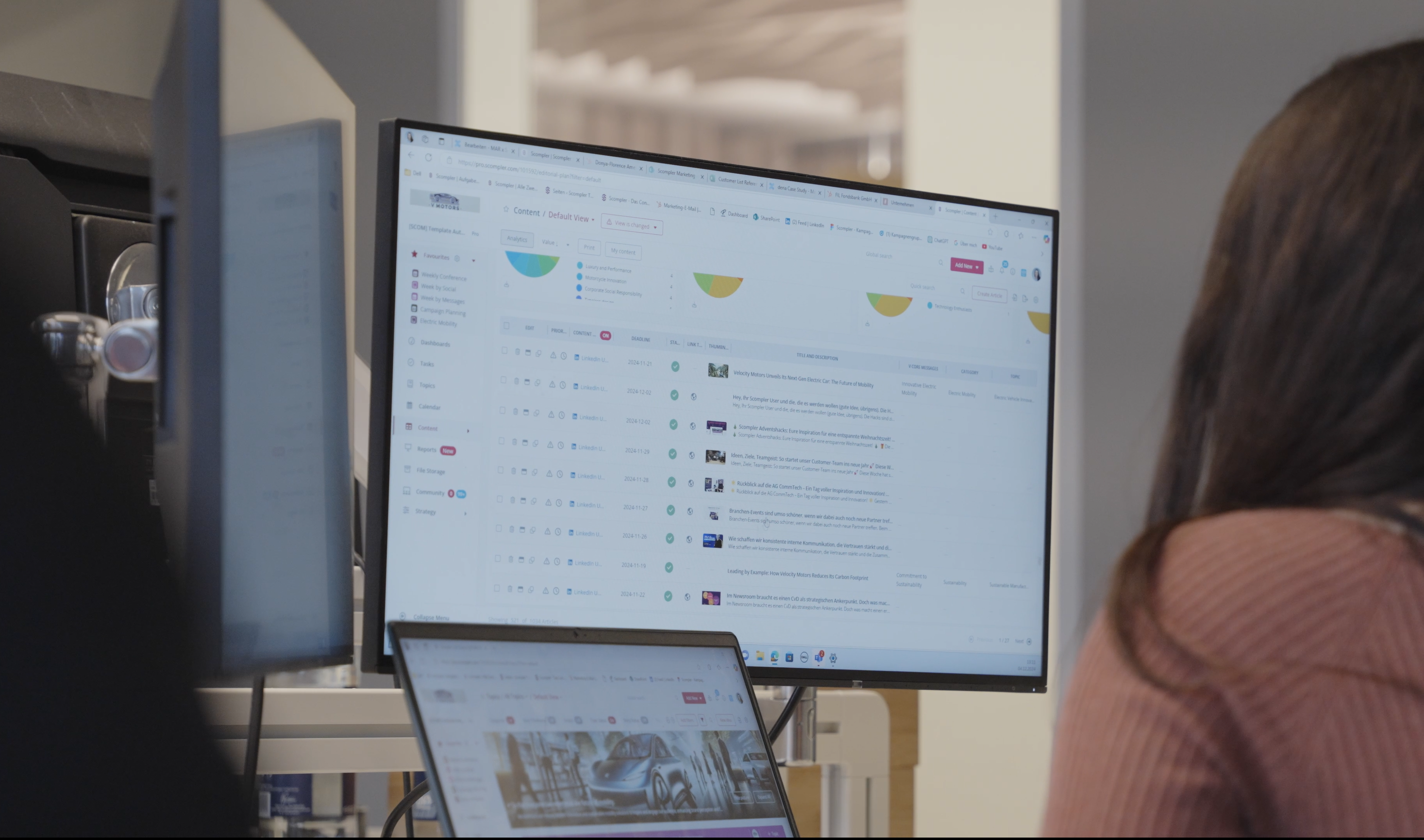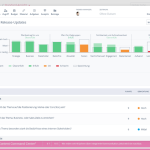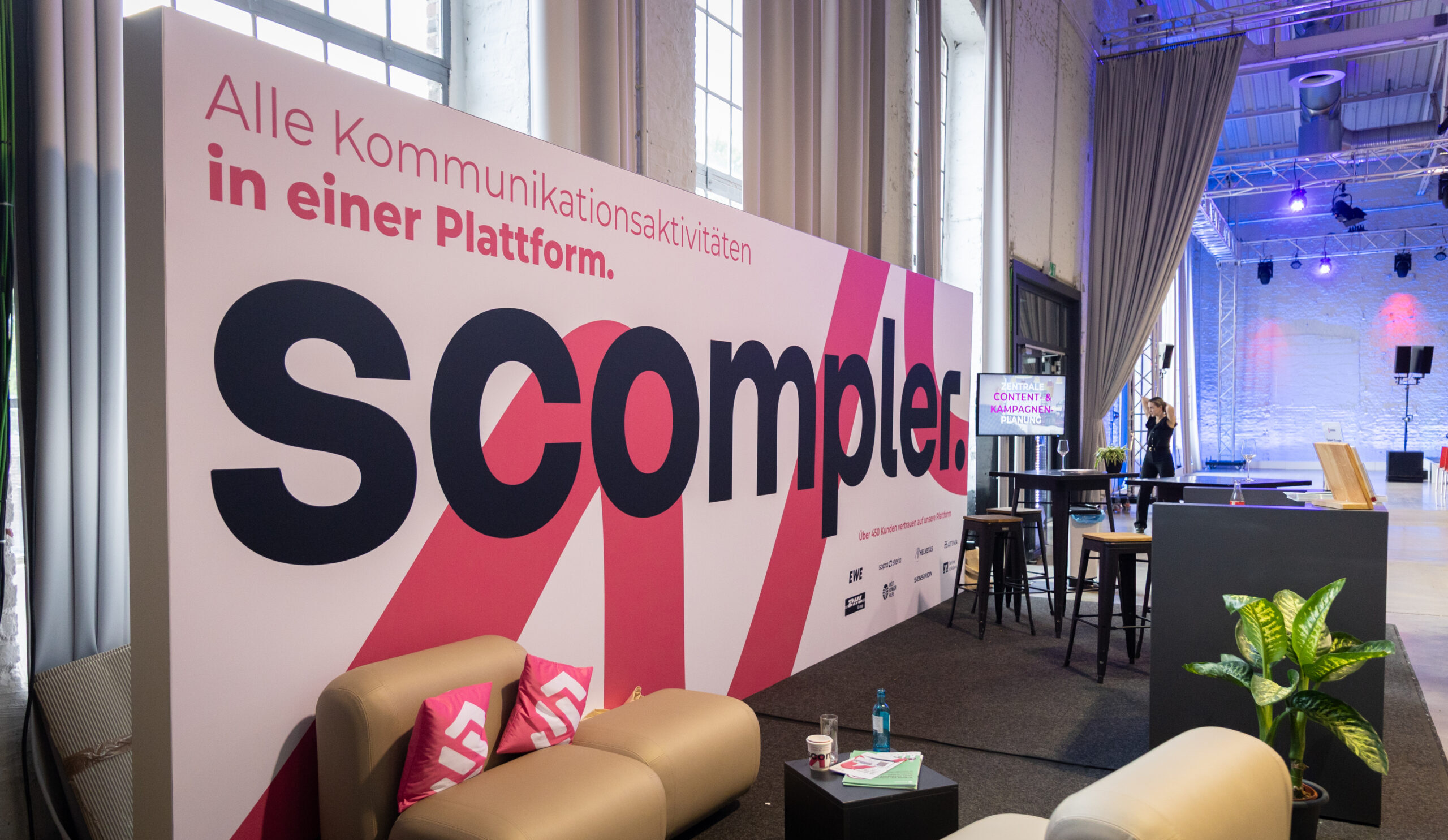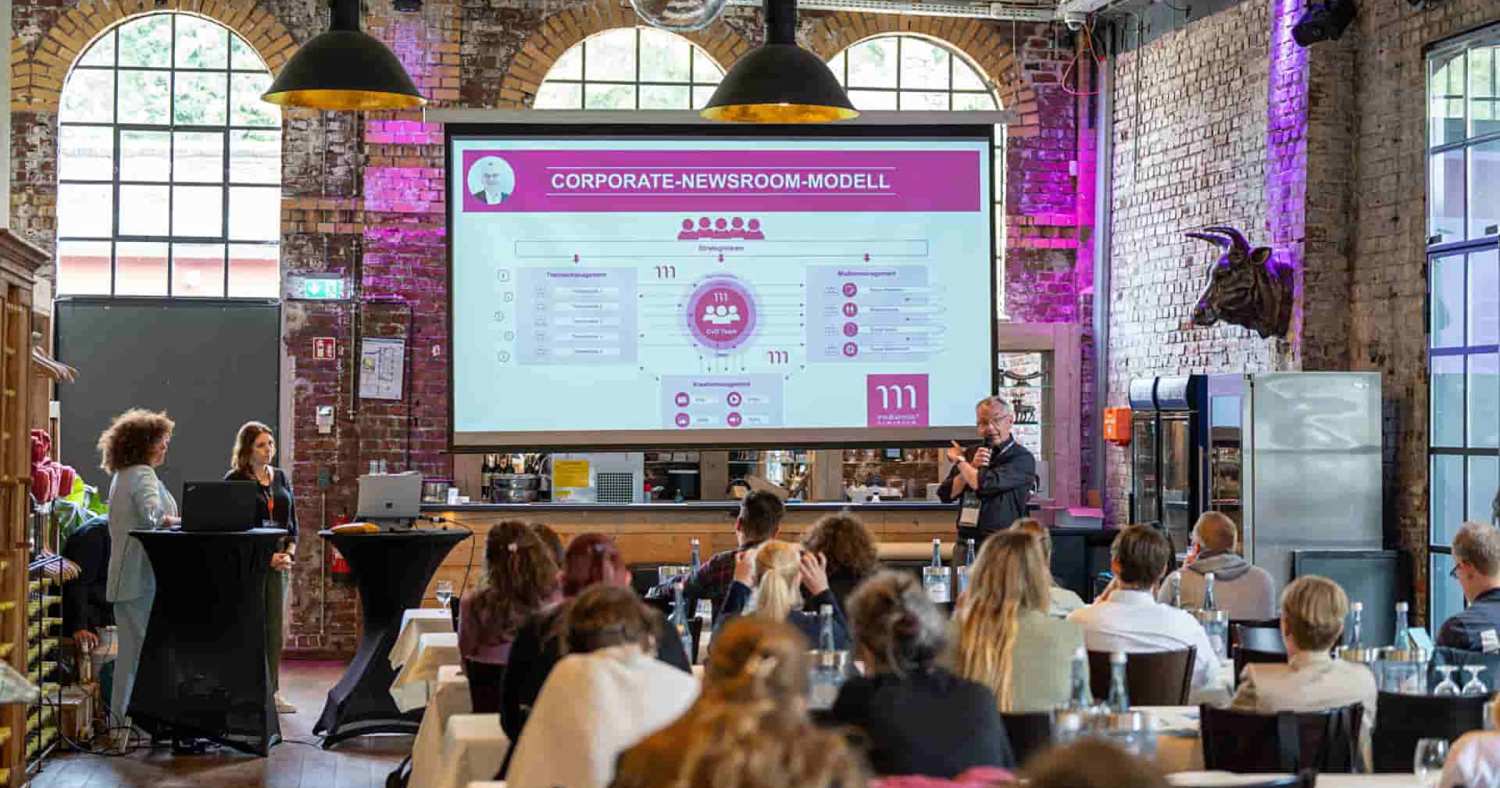Die besten Team Kollaborationstools für Marketing- und Redaktionsteams
Mirko Lange
In der heutigen dynamischen Arbeitswelt spielen Online Kollaborationstools eine entscheidende Rolle für den Erfolg von Marketing- und Redaktionsteams. Besonders in Zeiten von New Work und Remote-Arbeit werden diese Tools zu unverzichtbaren Helfern, die effizientes und effektives Arbeiten erst möglich machen. In diesem Artikel werfen wir einen Blick auf die wichtigsten Kollaborationstools und beleuchten, wie sie den Arbeitsalltag der Marketing Teams verändern.
Beitragsdatum
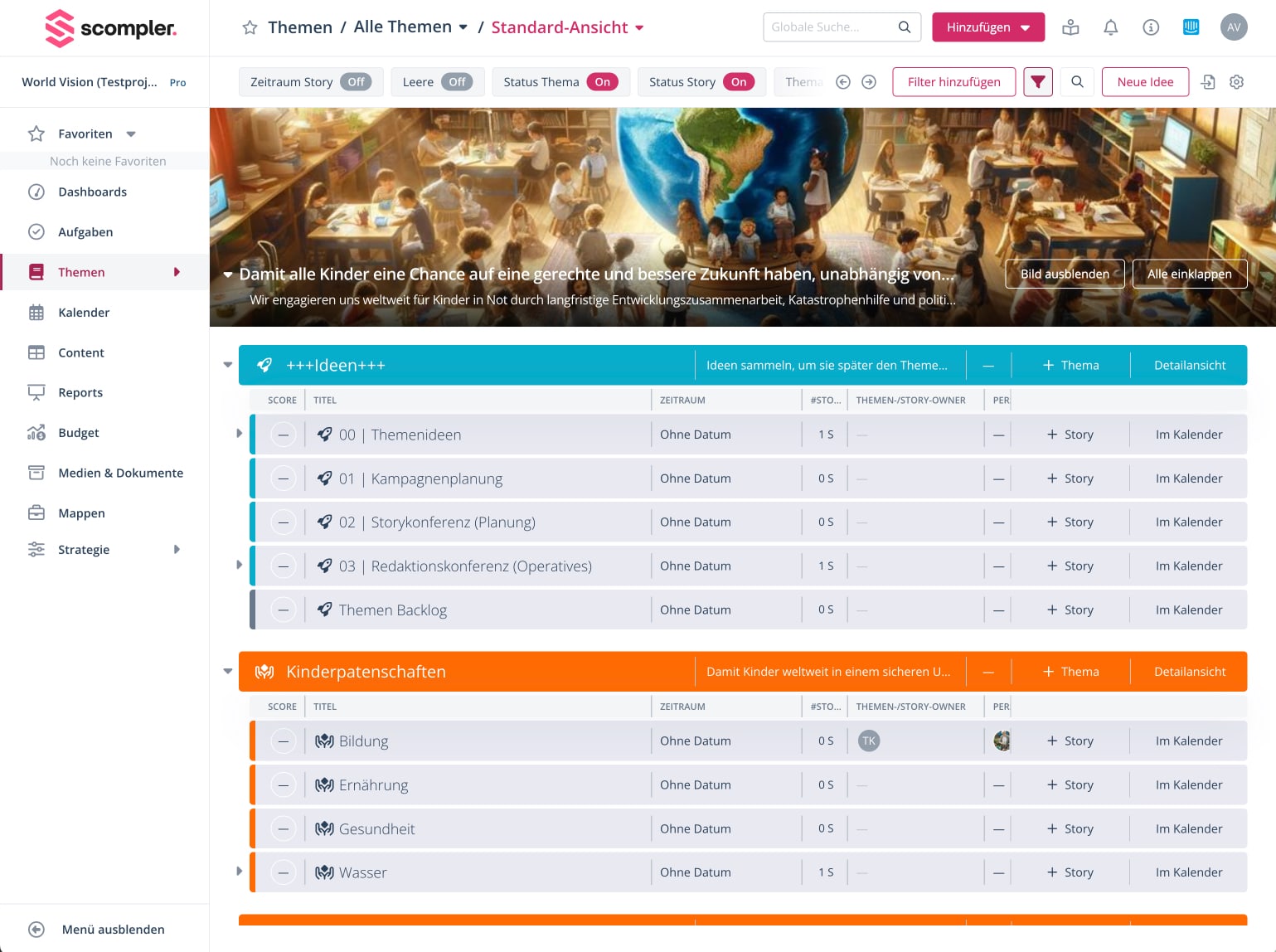
Definition
Was sind Kollaborationstools?
Kollaborationstools sind Softwarelösungen, die die Zusammenarbeit und Kommunikation zwischen Teammitgliedern in einem Unternehmen erleichtern.
Sie bieten eine Vielzahl von Funktionen, die es den Benutzern ermöglichen, gemeinsam an Projekten zu arbeiten, Dokumente zu teilen und miteinander zu kommunizieren, wodurch die Kollaboration und der Wissensaustausch besonders in Zeiten von Remote Work und digitaler Vernetzung unterstützt werden.
Kollaborationstools sind unverzichtbare Helfer, um effektive und effiziente Teamarbeit zu ermöglichen.
Online Kollaborationstools für Remote Teams
Online-Kollaborationstools haben sich zu einem unverzichtbaren Bestandteil der Remote-Arbeit entwickelt. Sie bieten eine Vielzahl von Funktionen und Möglichkeiten, die es Teams ermöglichen, effizienter und effektiver zusammenzuarbeiten. Dazu gehören unter anderem die Möglichkeit, von überall aus zu arbeiten, eine verbesserte Kommunikation sowie die Verwaltung von Projekten und Daten.

Wichtige Kollaborationstools im Überblick
Microsoft Teams
Microsoft Teams ist ein bekanntes Tool, das besonders in großen Unternehmen weit verbreitet ist. Es bietet nahtlose Integration mit anderen Microsoft 365-Anwendungen und ermöglicht Chats, Videokonferenzen, Dateiablagen und gemeinsame Dokumentenbearbeitung in Echtzeit. Für Marketing- und Redaktionsteams bietet es die Möglichkeit, Projekte und Kampagnen zentral zu koordinieren und die Kommunikation zu straffen.
Google Workspace
Google Workspace (ehemals G Suite) umfasst eine Reihe von Tools wie Google Docs, Sheets, Slides und Google Meet. Diese Anwendungen erleichtern die Zusammenarbeit an Dokumenten und Tabellenkalkulationen und bieten gleichzeitig leistungsstarke Kommunikationsmöglichkeiten. Besonders für Teams, die Wert auf cloudbasierte Lösungen legen, ist Google Workspace eine gute Wahl.
Slack
Slack ist bekannt für seinen benutzerfreundlichen Ansatz zur Teamkommunikation. Mit seinen Kanälen für unterschiedliche Projekte oder Themen bietet es eine klare Struktur und vermeidet Chaos in der Kommunikation. Außerdem lässt sich Slack mit zahlreichen anderen Tools integrieren, was die Effizienz weiter steigert.
Trello
Trello ist ein visuelles Projektmanagement-Tool, das auf dem Kanban-Prinzip basiert. Es ermöglicht Teams, Aufgaben auf Kanban Boards zu organisieren und den Fortschritt leicht nachzuverfolgen. Insbesondere für Marketingteams, die viele verschiedene Projekte parallel managen, ist Trello ein wertvolles Werkzeug.
Asana
Ähnlich wie Trello ist auch Asana ein leistungsstarkes Projektmanagement-Tool. Es bietet jedoch umfangreichere Funktionen für die Planung und Nachverfolgung von Projekten. Mit Aufgaben, Sub-Tasks, Meilensteinen und einer Timeline-Ansicht ist Asana ideal für Teams, die an komplexen Projekten arbeiten und eine detaillierte Übersicht benötigen.
ClickUp
ClickUp ist ein umfassendes Projektmanagement-Tool, das sich durch seine Flexibilität und Anpassungsfähigkeit auszeichnet. Es ermöglicht Teams, verschiedene Arbeitsabläufe zu verwalten, indem es Aufgaben, Dokumente, Ziele und Zeiterfassung in einer einzigen Plattform integriert. Durch die vielseitigen Anpassungsoptionen können Teams ihre Umgebung gemäß ihren spezifischen Anforderungen gestalten, was die Benutzerfreundlichkeit und die Effektivität erhöht.
Scompler
Scompler ist ein spezialisiertes Kollaborationstool, das besonders für Redaktionsteams entwickelt wurde. Es vereint Content- und Redaktionsplanung, Workflow-Management und Analyse in einer Plattform. Teams können hiermit ihre gesamte Content-Strategie planen, koordinieren und umsetzen. Besonders für Redaktionsteams, die sich auf Content Marketing spezialisiert haben, ist Scompler eine wertvolle Unterstützung.
Lust auf mehr?
Erfahren Sie, wie Scompler auch Ihrem Unternehmen helfen kann, die Kommunikation zu optimieren und die Effizienz zu steigern.
Kollaborationstools im Kontext von New Work
Vorteile der Kollaborationstools
Die Einführung von Team Kollaborationstools geht Hand in Hand mit den Prinzipien von New Work und der zunehmenden Verbreitung von Remote-Arbeit. Diese Tools ermöglichen es Teams, unabhängig von ihrem physischen Standort effizient zusammenzuarbeiten. Sie bieten Flexibilität, fördern die Transparenz und erleichtern die Kommunikation und Zusammenarbeit in verteilten Teams. Im Zuge der Digitalisierung fördert Collaboration Software Teamwork und Teamgeist im Unternehmen.
Verbesserte Kommunikation: Echtzeit-Chats, Videoanrufe und gemeinsame Dokumentenbearbeitung verbessern die interne Kommunikation erheblich.
Erhöhte Produktivität: Durch klare Aufgabenverteilung und einfache Nachverfolgung von Fortschritten wird die Produktivität gesteigert.
Flexibilität: Teams können von überall aus arbeiten und dennoch nahtlos zusammenarbeiten.
Transparenz: Alle Teammitglieder haben Zugriff auf die gleichen Informationen und können den Projektfortschritt live mitverfolgen.
Herausforderungen und Chancen
Trotz ihrer vielen Vorteile bringen Kollaborationstools auch Herausforderungen mit sich:
Technologische Hürden: Nicht alle Teammitglieder sind gleichermaßen technikaffin, was Schulungen und Anpassungszeiten erfordert.
Überlastung durch Tools: Zu viele Tools können zu Informationsüberfluss und Verwirrung führen. Eine klare Struktur und gezielte Auswahl sind daher entscheidend.
Auf der anderen Seite bieten diese Tools enorme Chancen:
Innovative Arbeitsweisen: Neue Prozesse und Arbeitsweisen können implementiert werden, die ohne diese Tools nicht möglich wären.
AI-Integration: Die zunehmende Integration von Künstlicher Intelligenz (AI) eröffnet weitere Möglichkeiten, wie z.B. automatisierte Aufgaben, intelligente Analysen und personalisierte Empfehlungen.

Scompler, das Kollaborationstool für Redaktionsteams
Ein herausragendes Beispiel für die erfolgreiche Nutzung von Kollaborationstools ist das Redaktionstool von Scompler. Vor der Einführung von Scompler stehen viele Marketing- und Redaktionsteams vor der Herausforderung auf diverse, nicht integrierte Tools angewiesen zu sein, um ihre Arbeit zu koordinieren. Dies führte oft zu ineffizienten Workflows und Kommunikationsproblemen. Scompler vereint alle wichtigen Funktionen von der Themenplanung, über die Content-Erstellung und -Verteilung, bis hin zu Workflow-Management und Analyse. Und das alles in einer Plattform.
Ein Vergleich zeigt, wie sich die Zusammenarbeit im Team ändert und welche Bedeutung das für Unternehmen hat.
Vorher:
Verteilte Tools: Teams nutzten verschiedene Tools für Planung, Kommunikation und Analyse.
Ineffiziente Workflows: Durch den Wechsel zwischen verschiedenen Plattformen ging wertvolle Zeit verloren.
Kommunikationsprobleme: Informationen gingen leicht verloren oder wurden übersehen.
Jetzt:
Zentrale Plattform: Mit Scompler haben Teams eine zentrale Plattform für alle Aspekte ihrer Arbeit.
Effiziente Workflows: Arbeitsabläufe sind klar strukturiert und transparent.
Bessere Kommunikation: Alle relevanten Informationen sind für alle Teammitglieder zugänglich und nachvollziehbar.
Lust auf mehr?
Erfahren Sie, wie Scompler auch Ihrem Unternehmen helfen kann, die Kommunikation zu optimieren und die Effizienz zu steigern.
Die Rolle der AI in Kollaborationstools
Künstliche Intelligenz spielt eine immer wichtigere Rolle in Kollaborationstools. Sie kann dabei helfen, repetitive Aufgaben zu automatisieren, Daten zu analysieren und wertvolle Einblicke zu gewinnen. Zukünftige Entwicklungen könnten beinhalten:
Automatisierte Content-Erstellung: AI könnte Inhalte automatisch generieren und personalisieren.
Intelligente Analysen: AI kann Daten analysieren und Handlungsempfehlungen geben.
Personalisierte Workflows: AI könnte individuelle Arbeitsweisen und Präferenzen lernen und dementsprechend automatisch optimierte Workflows vorschlagen.
Fazit
Collaboration Tools sind unverzichtbar in der modernen Arbeitswelt. Sie fördern Teamarbeit und ermöglichen, dass Teams effizient und effektiv zusammenzuarbeiten, egal ob im Büro oder remote. Durch die Integration von AI bieten sie zudem immer neue Möglichkeiten, die Arbeitsweise weiter zu optimieren und innovative Prozesse zu implementieren.
Auswahl und Vergleich des richtigen Kollaborationstools sind entscheidend für den Erfolg von Redaktionsteams. Es gibt keine Allround Lösung. Jedes der besprochenen Tools bietet eigene Stärken und Funktionen, die auf unterschiedliche Bedürfnisse eingehen. Die Integration dieser Technologien in den täglichen Arbeitsablauf fördert nicht nur die Effizienz, sondern auch die Kreativität und Innovationskraft der Teams. Daher sollten Unternehmen sorgfältig abwägen, welche Tools am besten zu ihrer spezifischen Arbeitsweise und Unternehmenskultur passen, um die Vorteile der digitalen Zusammenarbeit vollumfänglich zu nutzen.
Relevante Artikel
Learn how to grow your business with our expert advice.
Strategisches und wirkungsvolles Marketing bei Deutsche Bahn UX
Eine datengetriebene Themenplanung ist entscheidend für effiziente Kommunikation, wird jedoch oft vernachlässigt. Daten und Analysen spielen eine zentrale Rolle bei der Identifikation, Bewertung, Priorisierung und Strukturierung von Themen. Experten wie Michael Schmitz und Paul Ledder unterstützen Organisationen dabei, ihre Content-Strategien effektiv umzusetzen und komplexe Sachverhalte verständlich zu machen. Mittels Scoring und Scoping können Themen strategisch geplant und priorisiert werden, um eine zielgerichtete Kommunikation zu gewährleisten. Die Herausforderung besteht darin, die wirklich relevanten Themen zu identifizieren, um den Kommunikationsfokus beizubehalten und die Zielgruppen optimal zu erreichen.
Scompler-Gründer Mirko Lange verlässt operatives Geschäft: „Scompler hervorragend aufgestellt“
Datenbasierte Kommunikation wird als wichtiger Trend im Content Marketing und in der Unternehmenskommunikation angesehen, vor allem durch den Einfluss von KI-Systemen wie ChatGPT. Markt- und Meinungsforschung bietet Unternehmen eine exklusive und strategisch wertvolle Datenbasis für PR und Marketing. Diese Daten ermöglichen es, Trends zu identifizieren und die Effektivität von Kampagnen zu messen. Eine Umfrage von Scompler und Civey offenbart jedoch, dass nur etwa 25 % der Unternehmen diese Daten tatsächlich nutzen. Dies zeigt ein erhebliches ungenutztes Potenzial, das stärker ausgeschöpft werden könnte, um die Kommunikation zu verbessern und Wettbewerbsvorteile zu erzielen.

